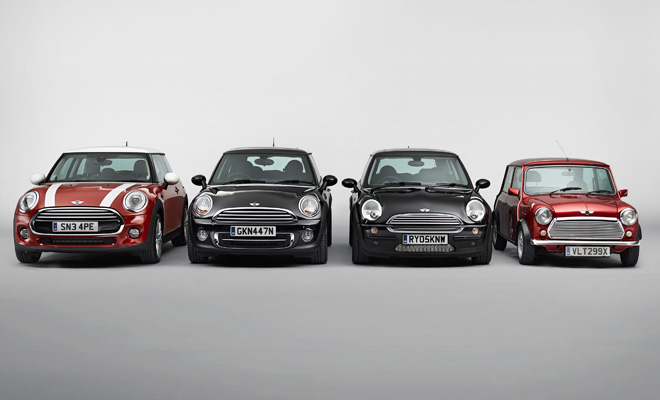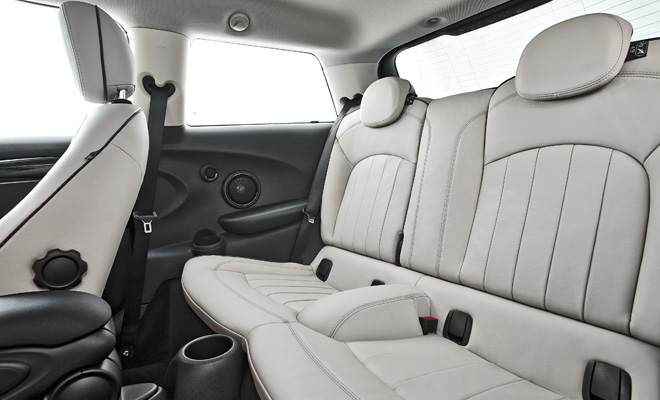by Lem Bingley 
Next spring will see the arrival of a brand new Mini – though at first glance you may be pushed to tell. This is the second major reinvention of the Mini since the ancient, 1959 car was replaced by something much more modern in 2001. And as with the last complete redesign, in 2006, it seems that not much has apparently changed.
However, there is more to the new Mini than meets the eye. Here are 10 big reasons to take notice of the new small car:

It’s more frugal than ever
BMW has so far released details of the Cooper, Cooper S and Cooper D editions of the 2014 Mini, and there are some big improvements in the economy and CO2 emissions figures. The diesel-powered Cooper D now swoops as low as 92g/km (compared to the outgoing car’s 99g/km) and also hits a combined cycle economy score of 80.7mpg (up from 74.3mpg). The petrol-powered Cooper, meanwhile, can be had with a 105g/km rating (down from 127g/km) and 62.8mpg score, while even the more manic Cooper S can manage a respectable 122g/km (compared to a best of 136g/km beforehand) and 54.3mpg.
And surprisingly it’s the automatic edition of the new Cooper S, rather than the six-speed manual, that’s more efficient at turning petrol into speed. While the outgoing auto gearbox felt as if it made use of treacle and sleeping pills, the new one has been supping Red Bull. The six-speed box still employs a torque-converter rather than a twin-clutch design, but it can be fully decoupled from the engine when idling or to allow coasting, helping to trim the most speedy Mini’s CO2 score by 11g/km while simultaneously knocking a tenth off the 0-62mph time.
And according to reports, a plug-in hybrid edition of the new Mini is also in the works, which ought to duck well under 50g/km.

It’s also quicker than before
Cuts in consumption have not come at the expense of the new Mini’s ability to get up and go. Acceleration figures are improved across the board, with the diesel Cooper D now half a second quicker to 62mph than before, the petrol Cooper a whopping 1.2 seconds swifter to the same measure, and the new Cooper S making a clean sweep of faster sprints by rubbing a couple of tenths from its time.
While few of us ever launch from a standstill with a stopwatch ticking, the swifter figures should translate into a new Mini that feels stronger and more eager than the previous edition.

It’s got driving modes
The 2014 Mini now boasts its own version of BMW’s Dynamic Drive Control, suitably rebranded. Whereas a 3-Series gets Eco, Comfort and Sport modes, the new Mini has Green, Mid and Sport options to choose among. The need for a new vocabulary is a mystery given that the end result is the same. Switching modes will attempt to redefine the character of the car using whatever can be switched or tweaked among its particular set of features and options, including throttle response, steering weight, engine noise, ambient lighting, auto gearbox shifting, and even the stiffness of the dampers.
And in case you can’t recall which mode you’ve chosen from that lot, the centre console will also light up green, amber or red to remind you.
If an automatic gearbox is fitted, Green mode will also enable a coasting function. Lift off the throttle without braking and both of the gearbox clutches will disengage, removing engine braking and allowing the car to sail forward on its own momentum.

It’s bigger than ever
The original Mini seems incredibly tiny and delicate by modern standards, never having had to pass a crash test or carry half the kit of today’s air conditioned monsters, but the latest Mini has put on another growth spurt. The 2014 model is almost 10cm longer than the previous car, which was in turn 7cm longer than its predecessor, which was itself more than half a metre longer than the original Austin-Morris tiddler. The latest car has also grown a little wider and a whisper taller too.
The best place to experience the new dimensions will be the rear seating, which should no longer resemble an optimistically padded parcel shelf. The boot has grown as well, by 30 percent to 211 litres, making it merely small (a Citroen DS3 swallows 285 litres) rather than teeny-tiny.
A rear bench split 60:40 rather than 50:50 may also improve practicality, assuming you have a passenger slim enough to fit in the 40%.

It hasn’t shot up in price
The 2014 Cooper starts at £15,300 on the road, up from £14,900 for the old Cooper hatch. Balanced against that increase is a modestly improved equipment roster. The Cooper D costs from £16,450, up from £16,180, while the Cooper S has crept up to £18,650 from £18,185 beforehand. These are relatively minor increases, given the general background hum of inflation.
Of course Mini showrooms have never been bargain basements, and the upmarket tendency continues. Plus the lengthy options list can only give the wallet a worse walloping. If you were hoping to get more for less with the new car you’d best move along.

The design is more different than it seems
A first glance might lull the eye into thinking nothing much has changed, but the new Mini is actually a more distinct design than the previous timid rejig. The sheet metal – previously modelled on a bar of soap – has gained a few defined creases. You can spot them around the wheel arches and around the lamps front and rear. The creases create a chamfered, bevelled-edge look to the panels that increases the impression of strength.
There’s also new sculpting at the bottom of the doors, catching the light and making the car’s sides seem less slabby. This trick helps the Mini look a little more slender than it otherwise might, giving a better visual balance between glass and metal.

The ergonomics are less iffy
The new Mini’s interior is still a very retro affair, dotted with circular motifs and toggle switches, but with a bit more good sense applied than last time around.
The instruments are now clustered where they belong, ahead of the steering wheel, while the big circular centre console is now devoted to housing a modern screen rather than a throwback dinner-plate speedometer. The window switches are now sensibly located in the doors, too.
And you no longer start the car by slotting a huge keyfob into a dashboard receptacle. There’s a neat red toggle in the middle of the car for switching on or off.
Best of all, you can now get a Mini with a full-colour head-up display, bringing things bang up to date.

There are apps for it
While most of us are happy if we can get our car to hook up to our smartphone, the new Mini has a slot of its own for a SIM card, turning it into a giant smartphone on wheels. The SIM allows the new Mini to trigger an automated emergency response to accidents, and to send servicing data over the air, or even to arrange a service. Other telematic services are no doubt in the pipeline, now that the facility is in place.
The new Mini will still synch via Bluetooth, of course, and a range of apps are available that will work via the car’s central screen once your phone is hooked up. Mini says it now supports Android as well as iPhone devices in this mode.
It should be safer
Bigger is generally better in an accident, and the new Mini should fare well when flung at impact barriers by Euro NCAP in due course. Unwary pedestrians may also prefer the new Mini as it has gained a pyrotechnic pop-up bonnet, helping to lessen any entanglements between squashy bits of people and unyielding lumps of engine.
Noises and lights will now attempt to alert a dozy driver of an impending collision, and the brakes can also be automatically deployed, at partial strength, to try to lessen the consequences of inattention at urban speeds.

The new Clubman ought to be better
There will be a new Mini Clubman model in due course, and spy shots reveal that it’s a long and low shooting-brake style car but with a pair of proper rear doors – as opposed to the one-sided, rear-hinged oddity of the current Clubman.
It won’t be a five-door hatchback, however, as the Clubman will retain the current vertically split, side-hinged, barn-door arrangement at its rear end. Which technically makes it a six-door car.
New Mini: 10 things you need to know
11 December 2013
Read more about: Mini small cars



